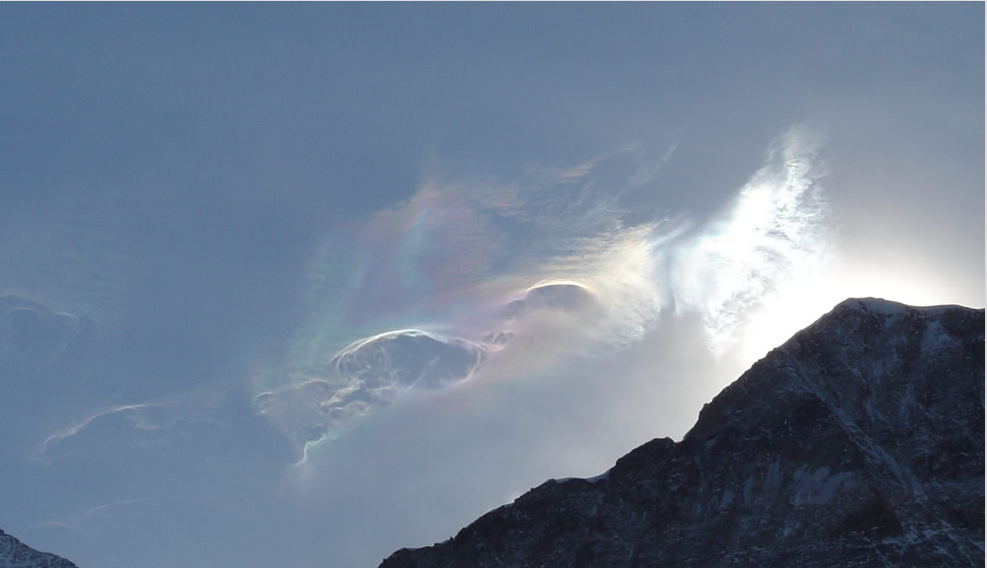Eiger Iridescence
Eiger Iridescence: A Captivating Natural Phenomenon
Have you ever witnessed the mesmerizing beauty of iridescent clouds near the Eiger mountain in Switzerland? These delicate displays of color, known as Eiger Iridescence, have captivated the hearts of many observers. In this article, we will delve deeper into this fascinating atmospheric optics phenomenon, exploring its causes, characteristics, and the science behind it.
Understanding Iridescence
Iridescence is a captivating optical phenomenon that occurs when light is diffracted, or scattered, by small particles or structures in the atmosphere. This diffraction causes interference, resulting in the separation of light into its component colors. When these colors overlap and interact, they create the stunning iridescent patterns we observe in nature.
The Role of Cloud Droplets
In the case of Eiger Iridescence, the primary cause can be attributed to cloud droplets. These droplets act as tiny prisms, scattering and diffracting sunlight as it passes through them. The size and uniformity of these droplets play a crucial role in determining the intensity and appearance of the iridescent colors.
Atmospheric Conditions for Eiger Iridescence
To witness the captivating display of Eiger Iridescence, specific atmospheric conditions must align harmoniously. Here are the key factors that contribute to the formation of this phenomenon:
-
Sun Position: The sun should be relatively low in the sky, typically within 6 to 12 degrees above the horizon. This angle allows for optimal interaction between sunlight and cloud droplets.
-
Cloud Characteristics: The presence of thin, high-altitude clouds composed of uniform water droplets is essential. These clouds should be thin enough to allow sunlight to pass through while maintaining sufficient density to scatter the light effectively.
The Science Behind Eiger Iridescence
The science behind Eiger Iridescence lies in the interaction between light and the cloud droplets. When sunlight encounters these droplets, it undergoes a process called diffraction. This process causes the light to bend and spread out, separating into its constituent colors. As a result, we perceive a range of vibrant hues.
The specific colors we observe during Eiger Iridescence depend on various factors, including the size of the droplets and the angle at which the light interacts with them. Smaller droplets tend to create blue and violet hues, while larger droplets produce warmer colors such as red and orange.
Other Instances of Iridescence
While Eiger Iridescence is undoubtedly captivating, it is not an isolated occurrence. Similar iridescent displays can be observed in various atmospheric phenomena, such as:
-
Mother-of-Pearl Clouds: Also known as nacreous clouds, these high-altitude polar clouds exhibit stunning iridescence due to their unique composition of ice crystals.
-
Rainbow Iridescence: Occasionally, rainbows can exhibit iridescent edges or fringes. This phenomenon occurs when sunlight interacts with raindrops, diffracting and creating additional colors.
Capturing the Beauty
Photographing Eiger Iridescence can be a rewarding experience for enthusiasts and professionals alike. To capture the vivid colors and intricate patterns, consider the following tips:
-
Timing: Plan your photography session during the golden hour when the sun is low in the sky. This lighting condition enhances the contrast between the iridescent clouds and the surrounding landscape.
-
Composition: Incorporate interesting foreground elements, such as mountains or trees, to provide context and depth to your images. Experiment with different angles and perspectives to create visually striking compositions.
A Nature's Masterpiece
Eiger Iridescence is a true testament to the wonders of our natural world. The delicate interplay between sunlight and cloud droplets creates a visual spectacle that enchants and captivates all who witness it. Whether you are an avid photographer, a curious observer, or simply a lover of nature's beauty, the allure of Eiger Iridescence is bound to leave a lasting impression on your heart and soul. So, keep your eyes to the sky and embrace the magic that unfolds before you.

Iridescent clouds near the Eiger. The delicate iridescence in freshly forming cloud was captured from Kleine Scheidegg in Switzerland by ESO astronomer Alan Moorwood. Image ©2004 Alan Moorwood, shown with permission.
Note: this article has been automatically converted from the old site and may not appear as intended. You can find the original article here.
Reference Atmospheric Optics
If you use any of the definitions, information, or data presented on Atmospheric Optics, please copy the link or reference below to properly credit us as the reference source. Thank you!
-
<a href="https://atoptics.co.uk/blog/eiger-iridescence/">Eiger Iridescence</a>
-
"Eiger Iridescence". Atmospheric Optics. Accessed on April 20, 2024. https://atoptics.co.uk/blog/eiger-iridescence/.
-
"Eiger Iridescence". Atmospheric Optics, https://atoptics.co.uk/blog/eiger-iridescence/. Accessed 20 April, 2024
-
Eiger Iridescence. Atmospheric Optics. Retrieved from https://atoptics.co.uk/blog/eiger-iridescence/.